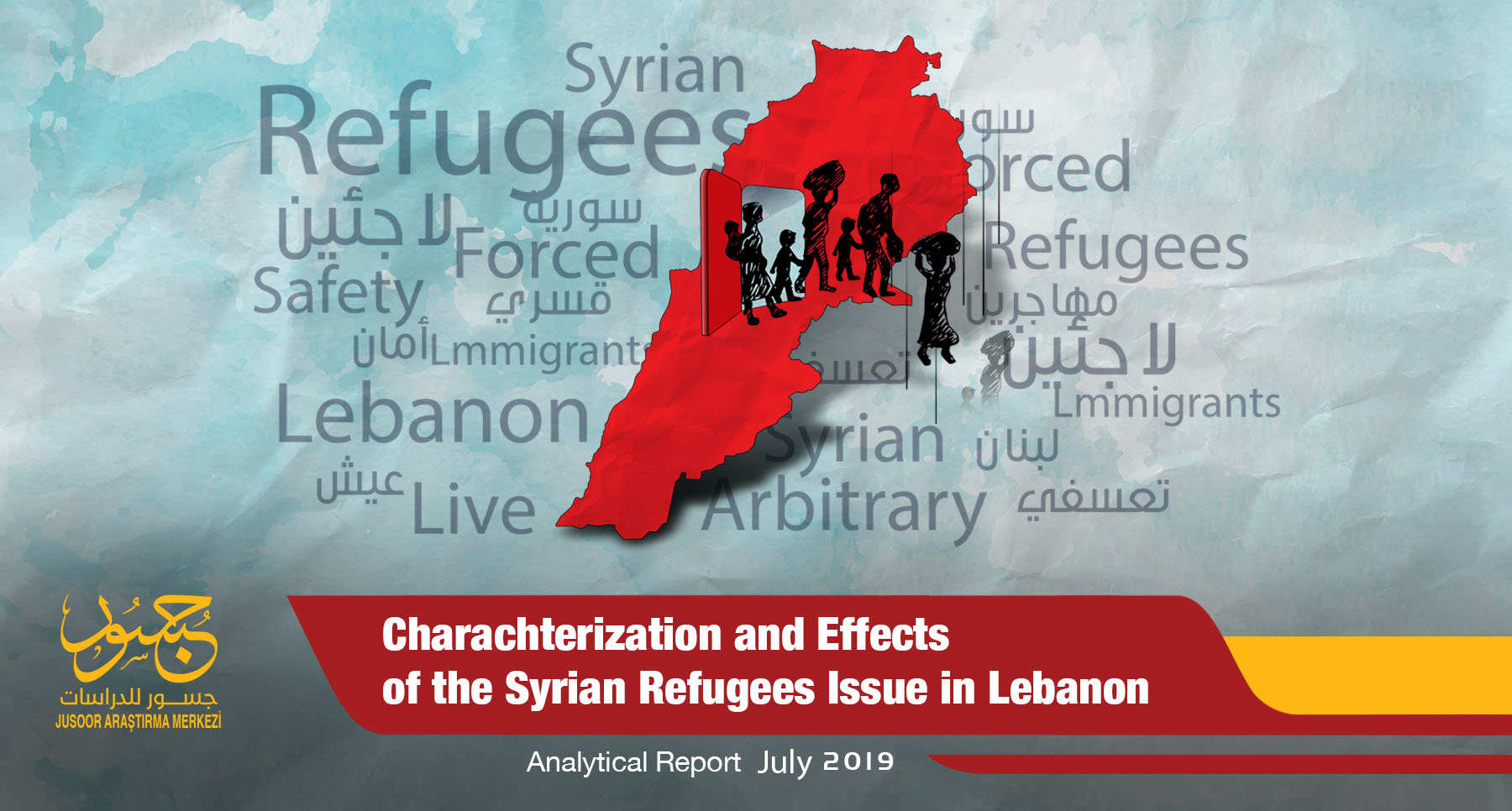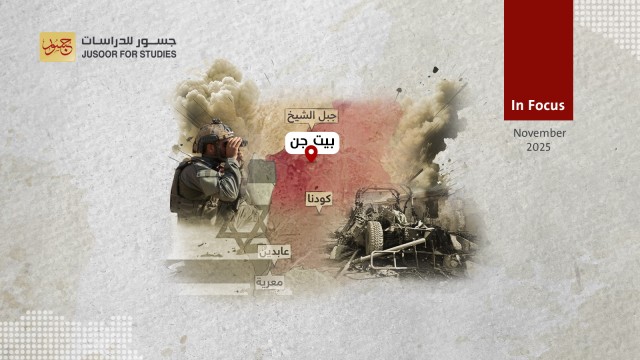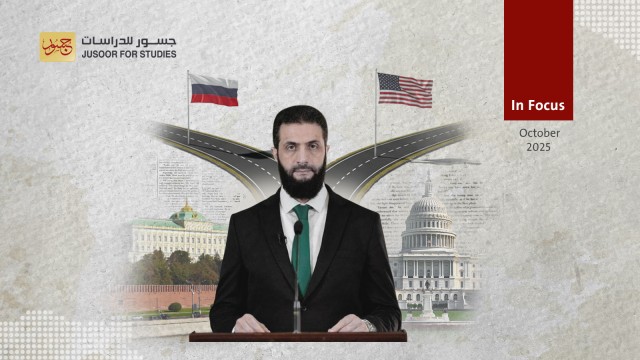Introduction
By the middle of 2019, the Syrian refugee crisis in Lebanon had returned to the Lebanese political scene with the rise in populist rhetoric among some of the political parties participating in the government. These parties and the rhetoric seeks to reduce the social, economic and political problems, that were existent in Lebanon prior to 2011, with the Syrian presence and its related effects.
Several parties’ populist discourse, especially the Free Patriotic Movement, contributed to the growing wave of racism and hate speech against Syrian refugees and against foreigners in general in a country where rates of racism is already high. Lebanon ranked second in the world in terms of rejecting foreigners and differences according to a study conducted a few years ago .
For all countries hosting Syrian or other refugees, recent years have witnessed unprecedented manifestations of racism. Government ministries, security services, municipal councils, well-known media, television programs, political parties and the like have all been involved in these manifestations of racism.
This report attempts to characterize of situation of Syrian refugees in Lebanon at all levels and consider the implications of the Syrian presence on the state and society.
First: Characterizing the Refugee Issue in Lebanon
Number of Refugees
According to government estimates, there are around 1.3 million Syrian refugees in Lebanon as of the end of 2018 . However, the United Nations (UN) estimates that there are around 935,000 refugees . The number is likely to be higher than the UN estimate, since the United Nations High Commission for Refugees (UNHCR) suspended the registration of Syrians arriving to Lebanon as refugees, at the request of the Lebanese government, since May 2015. Since then, the refugee file has been in the hands of the Lebanese General Security (LGS) which is responsible for all border movements, entrances and exits, and the affairs of all foreigners residing in Lebanon. The LGS has data and information about them foreigners residing in Lebanon including Syrian nationals.
The largest proportion of Syrian refugees in Lebanon (36%) are living in the Bekaa region, while 26% live in the Beirut-Mount Lebanon areas, 26% live in North Lebanon and South Lebanon receives the lowest percentage only 12% .
There are no official government or UN statistics on the number of Syrian refugees according to their place of birth. However, local estimates suggest that more than half of the Syrian refugees in Lebanon are from the border Syrian governorates of Damascus, the countryside areas of Homs and Hama, followed by those from the northern governorates and then Syria’s eastern and southern provinces .
Legal Responsibility
The Government of Lebanon is responsible for the management of the Syrian refugee file. Several government institutions coordinate with UNHCR, the Regional Coordinator, the World Food Program (WFP), the European Refugee Resettlement Program and around 100 international organizations on the issue of the Syrian refugee file. Local associations and civil society organizations are also involved in the process to respond to refugees’ needs.

It is noticed that in the Lebanese Government's handling of the Syrian refugee file and the UN response plans, there is no mechanism to organize and coordinate between public institutions as each ministry works independently with international organizations. The main reason for the lack of coordination mechanisms is the party and sectarian quota system implemented in Lebanon which gives each ministry the ability to adopt policies that may conflict with other ministries’ policies regarding the same file; and even conflict with the Prime Ministry’s policies on the same issue. All actors seek to maintain the status quo with the aim of giving each actor greater powers when they can take over a ministry.
Second: Refugees’ Living Conditions
1. Living Conditions
The majority of Syrian refugees, around 87%, are concentrated in the poorest areas of Lebanon. Around 30% of refugees live in heavily crowded cities, mainly in poorer neighborhoods. Syrians who are unable to live in urban areas, around 17% of all Syrian refugees in Lebanon, try to make their lives in the camps.
Lebanon is the only country among all the countries of refuge in the region that prevented the establishment of official refugee camps. At the beginning of the refugee crisis, the Lebanese government refused, under pressure from the Free Patriotic Movement and Hezbollah, to establish such camps, thereby preventing international and local organizations from providing systematic services for refugees as other countries did. In the process, refugees became vulnerable to blackmailing from private camp owners, a phenomenon that exists only in Lebanon, where landowners convert their land into a camp, and rent out tents or tin houses on a monthly basis. In other cases, refugees built the camps themselves with the help of some charities in uninhabited land. There are around 1,700 camps mostly located among the villages of the Akkar Plain in the north and the Bekaa. These camps host tens of thousands of Syrian families. The Lebanese Government regards all Syrian camps as informal settlements which gives the authorities the legal justification to demolish the camps at any time.
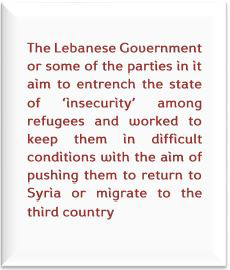
These camps, private or established by charities, do not adhere to the most basic human rights and internationally recognized standards. The camps lack infrastructure and basic services. There are no sewage networks. Some international organizations provide drinking water and waste disposal services from sewage cisterns. Access to electricity is also difficult as it is secured from local merchants for large sums which refugees are expected to pay. Refugees are also forced to pay the equivalent of 1.3 US Dollars (USD) on a monthly basis for garbage collection services. Every year, many refugees die or are injured due to weather conditions, especially during the winter season as refugee camps are unable to withstand rain, snow and the sever cold.
The Lebanese government's policy of dealing with the Syrian refugee camps has created a state of uncertainty among the refugees. Thousands of them have been forced to change their places of residence which threatens their ability to co-exist and to meet the minimum requirements to go on with their lives. It is believed that the state of “instability” is one of the government’s, or some actors within the government, most important motives with respect to their policies targeting the camps. These parties hope to push refugees either to return “voluntarily” to the regime-controlled areas in Syria or to try to escape to Europe – i.e. a third destination.
Camp residents send their children to work in the surrounding towns and cities to provide for their monthly food needs and secure greater opportunities for survival under difficult living and security conditions. The UN estimates that half of the Syrian refugees in Lebanon are children and women, and that most of the families send their children to work to secure the family livelihood.
2. The Economic and Social Conditions
Syrian refugees in Lebanon suffer from harsh economic conditions, and their lives are often characterized by instability at multiple levels concerning their security, livelihood and presence. Around 58% of Syrian refugees in Lebanon suffer from extreme poverty, and the percentage increases to 70% when considering refugees below the poverty line. This percentage increases to 94.5% when also considering those suffering from moderate or severe food insecure. According to UN estimates, 52% of Syrian refugees in Lebanon have very poor living standards and survive on only 2.4 USD per day, and 91% of Syrian refugees have an average debt of 857 USD .
UN agencies are providing financial assistance under a special protection program benefiting 6,850 refugees in Lebanon, with beneficiaries constantly changing with the changes to the UN needs assessment for most vulnerable families. For those included in the program, they receive assistance reaching 173 USD per month. The program targets an estimated 300,000 people, 30% of the Syrian refugee families, who are considered the families that most need financial assistance. However, according to UN statistics, there are another 25% of families that are not included under these financial assistance program but who are below the poverty line. WFP supports around 700,000 people with food aid, whereby individuals receive 27 USD .
Other than food assistance, UN agencies also provide winterization assistance amounting to 370 USD per person for heating and to help refugees meet other specific needs during the winter season. This program benefits around 857,000 refugees living in Lebanon.
A large proportion of Syrian refugees, both inside and outside the camps, do not receive UN assistance and face challenges securing their livelihood and ensuring their safety, protection and stability. Local and international organizations and even the Lebanese Government do not conceal this. The main problem is the lack of cooperation between the Lebanese Government and international organizations. In addition, the absence of official camps that would facilitate organizations easily reaching all refugees and enabling them to implement clear mechanisms such as in the case of the refugee camps in Jordan.
Access to work to meet minimum living requirements is a major challenge for Syrian refugees in Lebanon. Syrian refugees' entrance into the labor market has increased the unemployment rate of unqualified citizen workers, and refugee workers work for low wages compared with his local counterparts. Moreover, refugee workers often do not receive their salaries for long periods of time because employers or establishment lack the cash to pay them.
Some of the surveys conducted by local organizations report that the largest proportion of Syrian refugees’ work is limited to the agriculture and construction sectors. Their labor in these sectors is allowed under Lebanese labor law despite the difficult and bad living, security and legal situation.
3. Legal conditions
For Syrian refugees in Lebanon, the legal situation is the main dilemma in the absence of laws governing their residence and work, and the Lebanese Government’s inability to legislate such laws.
74% of Syrian refugees in Lebanon who are over the age of 15 live without a legal or valid residence permit. The cost of renewing residence permits is 200 USD per year, and the high sum acts as an obstacle preventing many refugees from obtaining the permit.
Refugees also face significant legal problems when renewing their residence permits related to security officers’ moods or their unwillingness to complete the process. In some cases, refugees renewing their permits have even faced the threat of being detained for a period of up to four days under the pretext of verifying the refugee’s personal data and activities on Lebanese territory. In addition, refugees face obstacles and difficulty or officials’ unwillingness to apply the exemption from fees issued by the Public Security in February 2017. The exemption from fees includes refugees registered with the UN before 2015 for reasons of tourism, care, property or rent.
The Lebanese Government’s security approach strengthens the mobility difficulties Syrian refugees face as they fear temporary detention or even deportation. Since the beginning of 2019, the Internal Security Forces (ISF) have deported many people due to their legal residence ending. The forces also launched several raids to arrest Syrians without residence permits and they were deported to Syrian regime outposts on the common border.
In Lebanon, only 0.5% of all working-age Syrian refugees have work permits, due to the strict legal procedures imposed by the government. For Syrian refugees to obtain a work permit, they must have a valid residence permit through which their employer applies for a work permit for the refugee worker.
This reality places thousands of Syrians at risk of being arrested and deprived of their livelihoods . Without the sponsorship regime, Syrian refugees cannot guarantee their continued work or ensure they are not arrested by the ISF.
Legal problems for Syrian refugees extend to the issue of registering newborn children. According to UN statistics, there are thousands of unregistered children, around 83% of the 130,000 refugee children born in Lebanon. The UN warns that these children face the risk of remaining without registration or formal recognition.
According to the UN assessment, there are several reasons which prevent parents registering their children including: the length of the process, the lack of awareness among the refugee population regarding registration requirements, and the absence of documents such as marriage license or residence due to the forced displacement .
The Un figures do not reflect the reality on the ground, and the opaqueness of the situation increased with the Lebanese Government taking over the Syrian refugee file. According to the Lebanese Government, around 260,000 Syrian children have been born in Lebanon who do not hold any nationality including the Syrian nationality. These children will be without status unless exceptional measures and facilitation are taken by Lebanon to register them formally. It will be necessary to cooperate with local and international organizations to facilitate this process, and especially to sensitize parents.
Third: The implications of Syrian Refugees’ Situations in Lebanon
The Syrian refugee crisis has placed Lebanon in front of an unprecedented crisis and challenge as Lebanon has become the most densely populated refugee country in the world. Lebanon is unable to deal with this issue not only due to its weak capabilities and resources but also due to the lack of desire or willingness to do so.
1. The Impact on the Social Level
The increase in the population has increased the pressure on public services that already have limited capabilities. The increase also drained already fragile infrastructure exacerbating tensions between the local population and Syrian refugees, especially given the government’s weak provision of public service originally and the weakness of its response to the Syrian refugee crisis. This social tension has come to bear the marks of racial discrimination, with the existence of social and political roots for this discrimination among certain segments of Lebanese society. Additionally, some of the political parties have invested this discrimination using through various tools, most notably hate speech, incitement and practices against the arrivals .
The limited support refugees receive and received from international and local organizations has also helped to provoke those belong to impoverished class in Lebanon, as in practice, refugees are in competition with this class. Hundreds of thousands of Lebanese live in or around shantytowns without receiving any form of support from the state. Each human settlement is left to the care of a political leader who provides the basic services to survive in exchange for using these blocs during elections or process of political, security or military mobilization.
The local poor’s visible sensitivity towards the support refugees receive is a known global phenomenon, and international organizations operating around the world adopt an approach to support local communities close to refugee communities to reduce these sensitivities. However, the Lebanese Government’s refusal to establish official refugee camps and its refusal to cooperate with the organizations providing supporting has significantly reduced the programs that aim to target local and refugee communities together.
It should be noted here that since 1948 the Palestinian refugee community in Lebanon has received regular assistance through The United Nations Relief and Works Agency for Palestine Refugees in the Near East (UNRWA) or other international organizations and Palestinian political entities. The assistance and services are higher in quantitative and qualitative than those provided to Syrian refugees since 2011; however, their impact on Lebanese society has been less since the Palestinian refugees live in closed camps unlike Syrian refugees who live in ‘camps’ directly in poor communities.
2. The Impact at the Political Level
The different political forces transformed the refugee issue into a field of political investment, where factions within the Lebanese Government are extorting the international community to obtain as much foreign funding as possible; however, the funding received is not reflected in the provision of services for refugees. This systematic blackmail is used internally to win followers and weaken opponents. Targeting refugees in all ways possible has become a means of expressing “patriotism” and those who abstain from participating in the hate campaigns are considered participants in the sale of Lebanon or in changing its demographic map.
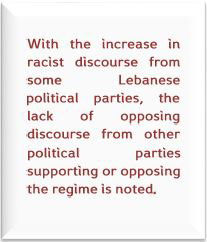
In the 2018 parliamentary elections, the refugee issue was present in the electoral campaigns, especially by the campaigns of the Free Patriotic Movement which adopts racist campaigns against the Syrian refugee presence. Such campaigns have the possibility of attracting a Christian voter who has fears that are fueled by much intimidation and false news, while weakening Christian parties opposed to the Syrian regime, such as the Lebanese Forces, the Movement’s fierce rival.
In contrast to the rise in racist attitudes on the far right, represented by the Free Patriotic Movement, the rhetoric is also observed in most other currents, including among those political movements hostile to the Syrian regime or which defend it or fight alongside it.
These various parties’ failure to present an alternative discourse is attributed to one or more of the following grounds:
- Some of the political parties are involved with the Free Patriotic Movement due to political interests, such as the desire to blackmail the European Union and receive European support for the government’s budget; targeting refugees then becomes a detail justified by the end goal that benefits all parties.
- Some of the parties share the same racist attitudes expressed by the Free Patriotic Movement, but these parties do not wish or cannot express them in the same way due to internal and external political considerations.
- The parties’ unwillingness to enter politically useless battles with their supporters as some of their supporters may share the same racist tendencies of the Free Patriotic Movement.
- The political balances in Lebanon which forces parties to work in coalitions even if their political orientations are different and pushes them to delay clashes to a time when the clashes serve their political agendas rather than their adopted principles and orientations.
But it is important to indicate the role of some civil society organizations, activists, politicians and media professionals, who are countering the escalating racist rhetoric, and exposing themselves to being targeted by racist groups. These groups regularly organize solidarity vigils with refugees, use the platforms available to them to disseminate their views, and many provide legal and charitable services to refugees .
3. The Impact on the Economic Level
Since 2011, Lebanon has absorbed an economic burden that is greater than its economic and social structure can handle. The large number of Syrian refugees undoubtedly exacerbated the problems Lebanon was already facing prior to the crisis. Some statistics indicate that the rate of unemployed has increased to about 20%. Also the size of the informal economy has increased due to the presence of skilled refugee workers and cheap refugee labor compared to Lebanese workers who are not satisfied with low wages.
However, attributing the Lebanese economy’s problems to the Syrian refugee presence is exaggerative and even misleading. The problems of the Lebanese economy did not start in 2011 and will not end when all Syrian refugees leave the country. In 2010, the poverty rate was around 30%, and it is still at this rate in 2019. Moreover, the widespread corruption did not arise with the arrival of refugees (although corruption was spread during the other Syrian presence when Lebanon was directly controlled by the Syrian security services).
It should also be noted that the main impact on the Lebanese economy after 2011 was due in a significant part to the closure of the Syrian borders with its neighboring countries. Between 2010 and 2015, Lebanon witnessed its revenues going down by half from 5 USD billion to 2.4 USD billion. The closure of Syria’s borders halted most of the exportation of Lebanese goods to the Arab Gulf countries and Turkey as well as halting the importation of low-priced Syrian industrial products. Lebanese producers were forced to find alternative markets. These came in addition to the stagnation of the tourism sector .
In fact, Lebanon has not benefited from the funds the international community injected into the country to respond to the refugee crisis. The funds were supposed to address aspects related to infrastructure, the health, education and labor market sectors. However, the funds were not benefitted from often due to the lack of a plan or policy to deal with the refugee file, which promotes corruption and the opportunity for individual state institutions to handle the sums received in an irregular manner that is suspected of corruption.
At the individual and private levels, large segments of Lebanese society have benefited financially and productively benefits from the Syrian refugee presence; although other social groups consider themselves negatively affected by the Syrian refugee crisis.
Fourth: The Future of the Asylum Issue in Lebanon
The summer of 2018 witnessed the launch of three initiatives to return refugees to Syria. The first came from the Russian side, while the remaining initiatives came from Iran’s allies in Lebanon: Hezbollah and the pro-Hezbollah Lebanese General Security Services.
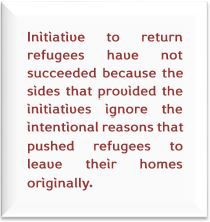
These initiatives received support from all the parties in Lebanon that support the Syrian regime Including the Free Patriotic Movement. These initiatives were supposed to result in the return of a large segment of Syrians in Lebanon to their country, thus alleviating the Syrian refugee burden in Lebanon, reinforcing the regime and its allies’ claims that it has won the war, helping to accelerate Russian efforts to launch a political solution and initiate the reconstruction process.
Despite the miserable living conditions of most Syrian refugees in Lebanon and the violations committed against them at the state and sub-state level, these initiatives have not yet achieved success even one year after their launch. According to UN estimates, the number of Syrian refugees who returned from Lebanon between July and March 2019 does not exceed 15,000 while the Directorate of Public Security reported that this figure reached 100,000 and the Russian government estimated 55,000 .
Even if the Russian data is assumed, the number of refugees returning to Syria in the past nine months is around 142,000 people, i.e. around 2.7% of the refugee registered as of 18 July 2018 – the day the initiative to return refugees was announced . Therefore, the number of returnees according to the Russian government - regardless of the accuracy of the figures- is below the level of immediate expectations provided by Moscow when it launched the initiative .
These figures mean that the (voluntary) return of refugees has not worked. This failure is due to several reasons, the most important are: security concerns which the regime’s allies in Russia and Lebanon refused to provide any guarantees about, the regime’s pre-security scrutiny process, the continued mandatory military service, and the poor living conditions in Syria.
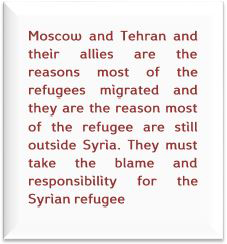
In the medium term it does not appear that any of the variables regarding Syrian refugees in Lebanon will change whether in terms of refugees’ return to Syria or their departure to a third country. A change in variables is dependent on a real change in the reasons preventing refugees from returning which the regime’s allies can affect as much as the regime’s allies in Moscow and Tehran. They are the ones who should bear the blame and the responsibility for the Syrian refuge, and not an ordinary person whose house was destroyed by an explosive barrel and who had no choice but to live in an organized settlement and is forced pay tax for the miserable tent he lives in.
Although Syrian refugees’ return is very complex, there are some basic steps that the regime’s allies can take that will contribute significantly to the return of refugees, especially as tens of thousands of them have not participated in almost any acts of opposition. The most important of these steps:
- Provide guarantees of non-prosecution and these guarantees must be provided through a committee that includes some of the regime’s allies along with a credible international authority. The committee can follow individual cases and intervene to release any person arrested from among the returnees.
- Enable international agencies, especially the UNHCR, to visit returnees inside Syria to ascertain their living conditions after their return, and to enable them to communicate freely with the returnees, whether through direct visits or by means of communication.
- The militias subordinate to Iran have evacuated the houses and areas from which many of the Syrian refugees present in Lebanon belong, especially in Qalamoun, al-Qusayr and other areas. They evacuated these areas to convert them of into military and sectarian settlements which will necessarily prevent the refugees from returning as their return would mean they will again live in tents, but this time under the influence of the regime’s security forces.
Other international actors, especially the European Union and France in particular, have a major responsibility in this regard, most notably by not allowing some Lebanese parties to use refugees as a tool to blackmail donors. Donors responding to this blackmail will result in those factions continuing to use these practices and persist in the abuses they are committing against refugees. In addition, this response – when it happens – forms a support for these factions, which openly provide support, in various forms – political, economic, security and even militarily- for the regime that caused the forced migration of the largest proportion of refugees.
Margins:
1- For more details of the study conducted by Swedish researchers in 2013: A fascinating map of the world’s most and least racially tolerant countries, Washington Post, 15/3/2013
2- “Director of the Lebanese General Security: 1.3 million Syrian refugees in Lebanon and 50 thousand returned to their country” Kuwait News Agency (KUNA), 10.10.2018.
3- Operational Portal-Refugees Situation, UNHCR, 31/5/2019
4- Operational Portal-Refugees Situation, UNHCR, 31/5/2019
5-‘101 Facts and Figures on the Syrian Refugee Crisis’, Issam Fares Institute for Public Policy and International Affairs, pp. 41-43, 1.1.2018.
6- “Lebanon Crisis Response Plan 2017-2020,” UNHCR p.14, ،
7- “Syrian Refugees in Lebanon… Is the assistance reaching the beneficiaries?” Infomigrants 12.02.2019,
8- ‘101 Facts and Figures on the Syrian Refugee Crisis’, Issam Fares Insitute for Public Policy and International Affairs, pp. 52-53, 1.1.2018.
9- ‘101 Facts and Figures on the Syrian Refugee Crisis’, Issam Fares Insitute for Public Policy and International Affairs, p. 55, 1.1.2018.
10- “Sari Hanafi: Are the Lebanese Racist?” al-Modon,
11- For example, a large group of public Lebanese figures announced on 25/06/2019 a statement countering the rising racist discourse against Syrian and Palestinian refugees in Lebanon. See: Lebanese Lawyers, Journalists and Activists: Against Racism, al-Modon, 25.06.2019,
12- In 2018, for the sixth consecutive year, Lebanon occupied the 138th position out of 180 in the international corruption perceptions index. See: Corruption Perceptions Index 2018, Transparency International
13-“Syrian Refugees… Unexpected gains for the Lebanese Economy,” Orientxxi, 9.01.2019,
14- The Displacement Dilemma: Should Europe help Syrian Refugees return home?, The European Council on Foreign Relations, March 2019, p4
15- Operational Portal Refugees Situation, UNHCR
16-“The Russian Defense: Around 200,000 Refugee Might Return to Syria in the Near Future,” Sputnik, 24.07.2018






